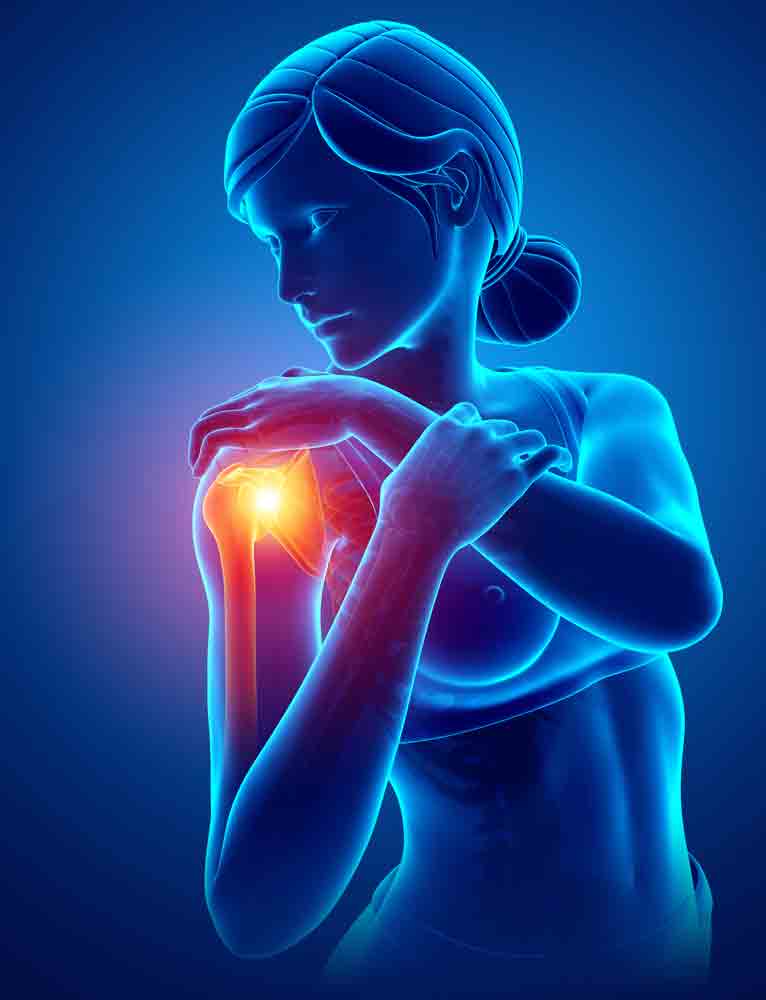Our shoulders are designed like a ball and socket, but very different from the deep sockets that hold our hips. In fact, many compare shoulder sockets to a golf ball sitting on a tee. Because these sockets are so shallow, our shoulders rely heavily on the surrounding shoulder blade and rotator cuff muscles to maintain the balance between mobility and stability.
The term rotator cuff refers to the muscles and tendons that connect the upper arm bone (i.e. humerus) to your shoulder blade (i.e. scapula) and collarbone (i.e. clavicle). The rotator cuff helps raise and rotate the arm while also keeping the upper arm bone tightly in the collarbone bone socket. Between the upper part of the shoulder blade (i.e acromion) and the rotator cuff tendons is a lubricated sac of tissue called bursa. Bursae are actually located all over the body where tissues must rub against each other. In this case, the bursa protects the acromion and the rotator cuff from grinding against each other.
Why do I have problems with Shoulder Pain?
Usually, there is enough room between the acromion and the rotator cuff so that the tendons slide easily underneath the acromion as the arm is raised. But each time you raise your arm, there is a bit of rubbing or pinching on the tendons and the bursa. This rubbing or pinching action is called impingement. Usually this doesn’t lead to any prolonged pain. But having poor posture, continuously working with the arms raised overhead, repeated throwing activities, or other repetitive actions of the shoulder can cause the impingement to become a problem. As a result, nearly 60 to 70 percent of us will deal with shoulder impingement pain at some point. Typically, it happens in our 40s or 50s.
Shoulder Impingement Syndrome occurs when the space in the shoulder joints narrows (either because of structural issues or posture/movement related issues) and the rotator cuff tendons or bursa become intermittently trapped and compressed during shoulder movements, resulting in pain, inflammation and reduced mobility. When the rotator cuff tendons become inflamed the condition is called rotator cuff tendonitis. If the bursa becomes inflamed, shoulder bursitis will develop. Both these conditions can co-exist or be present independently. Both can result in pain, irritation, and reduced mobility.
What are the Symptoms of Shoulder Impingement Syndrome?
- An arc of shoulder pain approximately when your arm is at shoulder height and/or when your arm is overhead.
- Shoulder pain that can extend from the top of the shoulder to the elbow.
- Pain when lying on the sore shoulder.
- Shoulder pain at rest as your condition deteriorates.
- Muscle weakness or pain when attempting to reach or lift.
- Pain when putting your hand behind your back or head.
- Pain reaching for the seat-belt.
What happens if it isn’t treated?
If shoulder impingement isn’t treated, the inflammation can become chronic. This causes significant pain and limits daily and recreational activity. If tendons are pinched over time, they can tear – either partially or completely. A complete tear of the rotator cuff requires surgery to repair it. That’s why it’s important to address shoulder pain before it reaches this point.
What are the best types of treatment for shoulder pain?
Physical therapy can be very successful in treating shoulder impingement syndrome. Studies have shown that hands-on treatment of shoulder joints, neck, and upper back, coupled with specific exercises, can relieve shoulder impingement pain quickly and restore normal function significantly. When properly assessed and treated by a physical therapist, the factors that contribute to shoulder pain can be addressed and surgery can be avoided.
SOL Physical Therapy’s advanced, hands-on approach to treatment focuses on stretching, reducing pain, and increasing the range of motion. At SOL, you will work with your physical therapist to devise a treatment plan that is specific to your condition and goals. Your individual treatment program may include:
- Pain Management. Your physical therapist will help you identify and avoid painful movements, as well as correct abnormal postures to reduce impingement compression. Therapeutic modalities, like iontophoresis and ultrasound may be applied. Ice may also be helpful to reduce pain.
- Manual Therapy. Your physical therapist may use manual techniques, such as gentle joint movements, soft-tissue mobilization, and shoulder stretches to get your shoulder moving properly, so that the tendons and bursa avoid impingement.
- Range-of-Motion Exercises. You will learn exercises and stretches to help your shoulder and shoulder blade move properly, so you can return to reaching and lifting without pain.
- Strengthening Exercises. Your physical therapist will determine which strengthening exercises are right for you, depending on your specific condition. Often with shoulder impingement syndrome, the head of the humerus tends to drift forward and upward due to the rotator-cuff muscles becoming weak. Strengthening the rotator-cuff and scapular muscles helps position the head of the humerus bone down and back to ease the impingement. You may also perform resistance training exercises to strengthen your weaker muscles. You will receive a home-exercise program to continue your strengthening long after you have completed your formal physical therapy.
- Patient Education. Learning proper posture is an important part of rehabilitation. For example, when your shoulders roll forward as you lean over a computer, the tendons in the front of the shoulder can become impinged. Your physical therapist will work with you to help improve your posture, and may suggest adjustments to your work station and work habits.
- Functional Training. As your symptoms improve, your physical therapist will teach you how to correctly perform a range of functions using proper shoulder mechanics, such as lifting an object onto a shelf or throwing a ball. This training will help you return to pain-free function on the job, at home, and when playing sports.
Resources
Khan Y, Nagy MT, Malal J, Waseem M. The painful shoulder: shoulder impingement syndrome.
Wilk KE, Hooks TR, Macrina LC. The modified sleeper stretch and modified cross-body stretch to increase shoulder internal rotation range of motion in the overhead throwing athlete.
De Mey K, Danneels LA, Cagnie B, Huyghe L, Seyns E, Cools AM. Conscious correction of scapular orientation in overhead athletes performing selected shoulder rehabilitation exercises: the effect on trapezius muscle activation measured by surface electromyography.
Struyf F, Nijs J, Baeyens JP, Mottram S, Meeusen R. Scapular positioning and movement in unimpaired shoulders, shoulder impingement syndrome, and glenohumeral instability.
Castagna A, Garofalo R, Cesari E, Markopoulos N, Borroni M, Conti M. Posterior superior internal impingement: an evidence-based review

